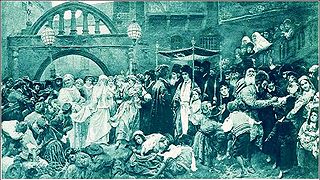
In traditional Judaism, marriage is viewed as a contractual bond commanded by God in which a man and a woman come together to create a relationship in which God is directly involved. Though procreation is not the sole purpose, a Jewish marriage is traditionally expected to fulfil the commandment to have children. In this view, marriage is understood to mean that the husband and wife are merging into a single soul, which is why a man is considered "incomplete" if he is not married, as his soul is only one part of a larger whole that remains to be unified.

A wedding is a ceremony where two people are united in marriage. Wedding traditions and customs vary greatly between cultures, ethnic groups, religions, countries, and social classes. Most wedding ceremonies involve an exchange of marriage vows by the couple, presentation of a gift, and a public proclamation of marriage by an authority figure or celebrant. Special wedding garments are often worn, and the ceremony is sometimes followed by a wedding reception. Music, poetry, prayers or readings from religious texts or literature are also commonly incorporated into the ceremony, as well as superstitious customs originating in Ancient Rome.
A white wedding is a traditional formal or semi-formal wedding originating in Great Britain.

An engagement, betrothal, or fiancer is a promise to wed, and also the period of time between a marriage proposal and a marriage. During this period, a couple is said to be betrothed,intended, affianced, engaged to be married, or simply engaged. Future brides and grooms may be called the betrothed, a wife-to-be or husband-to-be, fiancée or fiancé, respectively. The duration of the courtship varies vastly, and is largely dependent on cultural norms or upon the agreement of the parties involved.

A veil is an article of clothing or hanging cloth that is intended to cover some part of the head or face, or an object of some significance. Veiling has a long history in European, Asian, and African societies. The practice has been prominent in different forms in Judaism, Christianity, and Islam. The practice of veiling is especially associated with women and sacred objects, though in some cultures it is men rather than women who are expected to wear a veil. Besides its enduring religious significance, veiling continues to play a role in some modern secular contexts, such as wedding customs.

A ketubah is a special type of Jewish prenuptial agreement. It is considered an integral part of a traditional Jewish marriage, and outlines the rights and responsibilities of the groom, in relation to the bride. In modern practice, the ketubah has no agreed monetary value, and is never enforced, except in Israel.
Sheva Brachot literally "the seven blessings" also known as birkot nissuin, "the wedding blessings" in Jewish law are blessings that are recited for a bride and her groom as part of nissuin. In Jewish marriages there are two stages: betrothal (erusin) and establishing the full marriage (nissuin). Historically there was a year between the two events, but in modern marriages, the two are combined as a single wedding ceremony.
The money dance, dollar dance, or apron dance is an event at some wedding receptions in various cultures. During a money dance, male guests pay to dance briefly with the bride, and sometimes female guests pay to dance with the groom. The custom originated in Poland in the early 1900s in immigrant neighborhoods.

This article is about the wedding in Bangladesh, for wedding in West Bengal, India, see: Bengali Hindu wedding.

Marriage in Pakistan pertains to wedding traditions established and adhered by Pakistani men and women. Despite their local and regional variations, marriages in Pakistan generally follow Islamic marital jurisprudence. Culturally, marriages are not only seen as a union between a husband and a wife, but also an alliance between their respective families. These traditions extend to other countries around in the world where Overseas Pakistani communities exist.

A traditional Russian wedding can last between two days and one week. The celebration involves dancing, singing, toasting, and banqueting. The best man and maid of honor are called Witnesses or "svideteli" in Russian. The ceremony and the ring exchange take place on the first day of the wedding. Despite their seemingly unique matrimonial ceremonies, Russian weddings have adopted some western traditions, including incorporating bridesmaids into the wedding party.
Ukrainian wedding is the traditional marriage ceremony in Ukrainian culture, both in Ukraine and in the Ukrainian diaspora. The traditional Ukrainian wedding featured a rich assortment of folk music and singing, dancing, and visual art, with rituals dating back to the pre-Christian era. Over time, the ancient pagan traditions and symbols were integrated into Christian ones.

A ghoonghat is a veil or headscarf worn by some married Hindu, Jain and Sikh women to cover their head, and often their face. Generally aanchal or pallu, the loose end of a sari is pulled over the head and face to act as a ghunghat. A dupatta is also commonly used as a ghungat. Today, facial veiling by Hindu women as part of everyday attire is now mostly limited to the Hindi-speaking areas of India particularly Rajasthan, Uttar Pradesh and Bihar.

Bengali Hindu wedding refers to Bengali wedding with Hindu rites and rituals native to the Indian subcontinent.
Weddings in the United States follow traditions often based on religion, culture, and social norms.
Erusin is the Hebrew term for betrothal. In modern Hebrew, "erusin" means engagement, but this is not the historical meaning of the term, which is the first part of marriage.


















